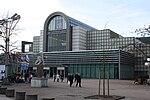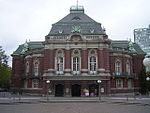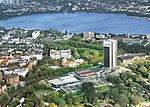Ernst-Merck-Halle
Buildings and structures demolished in 1986Buildings and structures in Hamburg-MitteDemolished buildings and structures in GermanyHamburg building and structure stubsMusic venue stubs ... and 1 more
Music venues in Germany
Ernst-Merck-Halle was a 5,600-capacity indoor arena located in Hamburg, Germany, that was opened in 1950 and demolished in 1986. It was named after German businessman and politician Ernst Merck. Artists that appeared at the hall include The Beatles, The Rolling Stones, Kiss, Iron Maiden, Queen, Pink Floyd, The Who, Santana and Deep Purple. The building was demolished in June 1986.
Excerpt from the Wikipedia article Ernst-Merck-Halle (License: CC BY-SA 3.0, Authors).Ernst-Merck-Halle
St. Petersburger Straße, Hamburg St. Pauli
Geographical coordinates (GPS) Address Nearby Places Show on map
Geographical coordinates (GPS)
| Latitude | Longitude |
|---|---|
| N 53.5603 ° | E 9.9794 ° |
Address
B3
St. Petersburger Straße
20355 Hamburg, St. Pauli
Germany
Open on Google Maps








